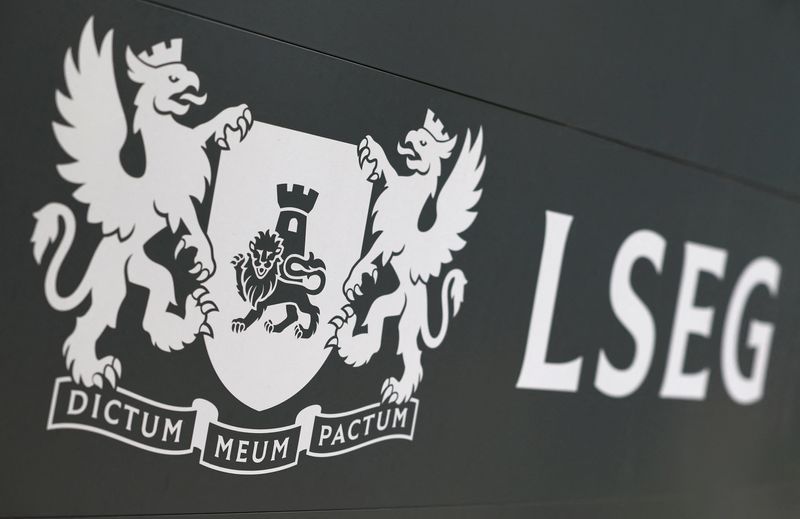By Sinéad Carew
NEW YORK (Reuters) -MSCI's global equity index advanced slightly, oil prices rallied on supply concerns and U.S. Treasury yields rose on Monday as investors digested mixed messages from the Federal Reserve about the prospects for 2024 interest rate cuts.
Oil prices climbed after Iranian-backed Houthi militants stepped up attacks on vessels in the Red Sea, raising concerns about supply disruptions.
Chicago Federal Reserve President Austan Goolsbee on Monday pushed back against market bets on interest rate cuts. Also pushing back against expectations for cuts on Monday was Cleveland Fed President Loretta Mester, who votes on policy in 2024 until her June retirement.
This was after investors on Wednesday and Thursday had celebrated dovish comments from Fed chair Jerome Powell when the central bank's meeting ended with interest rate projections from Fed officials showing an average expectation for three quarters of a percentage points of rate cuts in 2024.
Pushbacks on bets for a Fed pivot to easing had started on Friday when the Fed's New York President John Williams said it was "premature" to speculate about rate cuts.
Some traders saw the most recent comments as efforts to dampen over-enthusiastic reactions to expectations for easing.
“They want to continue to make it a mystery,” said Tom di Galoma, managing director and co-head of global rates trading at BTIG in New York.
“I think the Fed is completely done and there will be a lot of reasons for Fed rate cuts by mid-year,” he added, pointing to the economy being “due for a major slowdown in 2024.”
On Wall Street, the Dow Jones Industrial Average rose 0.86 points, or 0%, to 37,306.02, the S&P 500 gained 21.37 points, or 0.45%, to 4,740.56 and the Nasdaq Composite added 90.89 points, or 0.61%, to 14,904.81.
MSCI's gauge of stocks across the globe gained 0.13%. The pan-European STOXX 600 index earlier closed down 0.27%.
In bonds, longer-dated U.S. Treasury yields rose in reaction to Goolsbee's comments on Monday.
Benchmark 10-year notes were up 1.5 basis points to 3.943%, from 3.928% late Friday. The 30-year bond was last up 2.5 basis points to yield 4.0521%. The 2-year note was last was up 0.2 basis points to yield 4.4569%.
However, the U.S. dollar eased against the euro, extending last week's fall, as the U.S. currency remains under pressure from last week's signals about the possibility of rate cuts.
The dollar index, which measures the greenback against a basket of major currencies, fell 0.097%, while the euro was up 0.24% at $1.092. Sterling was last trading at $1.2644, down 0.24% on the day.
"The amount of pushback we've started to see post-Powell's press conference is clearly a risk to that downside USD view, though that pushback on the idea of cuts as soon as March seems largely to be falling on deaf ears thus far," said Michael Brown, market analyst at Trader X in London.
The Japanese yen weakened 0.51% versus the greenback at 142.90 per dollar as the Bank of Japan (BOJ) kicked off a two-day meeting that could be crucial in determining the timing of the end of the central bank’s ultra-loose stance on rates.
Also on investors' minds this week is the U.S. reading on core personal consumption expenditure (PCE) index due out on Friday as it will be closely watched for clues around the Fed's future policy decisions.
In commodities, oil closed higher after the Yemeni Houthi militant group Red Sea attacks disrupted maritime trade. Oil major BP (LON:BP) said it temporarily paused transit there and other shipping firms also said they would avoid the route.
U.S. crude settled up 1.46% to $72.47 per barrel after rising as much as 3.96% earlier in the day and Brent finished at $77.95, up 1.83% on the day.

In precious metals, gold gained ground as traders purchased bullion on price dips, while their focus shifted to key the upcoming inflation data for signals on the Fed's plans.
Spot gold added 0.4% to $2,026.62 an ounce. U.S. gold futures gained 0.58% to $2,026.30 an ounce.
